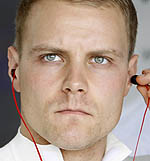 Pastor Maldonado: Montreal is definitely one of the most challenging tracks, especially when it rains as the downpours can be quite heavy. Obviously this causes changes to the strategy regarding pit stops and tyres. It also makes life much more challenging on the track because there are certain places where puddles form. In the past there has been a high frequency of safety cars during the race as well which will again affect race strategy. The track itself starts off very dirty on Friday because it's only used once a year and it isn't really until the Saturday qualifying session that more grip can be found after we have had a chance to lay down more rubber. It's interesting to drive on a track that changes so much as the weekend unfolds and the layout feels a bit like a street circuit which gets the adrenaline pumping. The whole city comes alive during the week of the Grand Prix and the atmosphere is one of the best all year so I really enjoy visiting Canada.
Pastor Maldonado: Montreal is definitely one of the most challenging tracks, especially when it rains as the downpours can be quite heavy. Obviously this causes changes to the strategy regarding pit stops and tyres. It also makes life much more challenging on the track because there are certain places where puddles form. In the past there has been a high frequency of safety cars during the race as well which will again affect race strategy. The track itself starts off very dirty on Friday because it's only used once a year and it isn't really until the Saturday qualifying session that more grip can be found after we have had a chance to lay down more rubber. It's interesting to drive on a track that changes so much as the weekend unfolds and the layout feels a bit like a street circuit which gets the adrenaline pumping. The whole city comes alive during the week of the Grand Prix and the atmosphere is one of the best all year so I really enjoy visiting Canada.
Valtteri Bottas: This will be my first time driving at Montreal and I'm looking forward to the challenge. It's similar to the last race in Monaco in some respects, being a street circuit with a number of the corners and straights very close to the walls. The challenge is therefore to quickly find the cars limit and use as much of the circuit as you can, without taking too many risks. I'm particularly looking forward to the last corner, the wall of champions, which is very iconic. As this is my first time driving the track, Friday morning is going to be important to get the right car setup. There are long straights on this circuit so good traction is needed out of the slow speed chicanes, and you also need really good straight line speed, especially in the race. If you have better straight line speed than your competitors, the racing will be much easier for you to defend and overtake so we need to find a good compromise between downforce and drag.
Mike Coughlan, Technical Director: The track is quite challenging with high speed straights and tight slow corners, which makes it very hard on brakes. Montreal has the lowest pit loss time of the year, at 15.9 seconds, which typically favours higher stop strategies, however there is a relatively high chance of getting a safety car around here. The track roughness is the lowest of the season and coupled with low tyre energy this can lead to a high tendency towards tyre graining. Weather is also a factor here as the low temperatures can cause trouble for the tyres due to the circuit layout and rain is always a threat. We had a difficult weekend in Monaco, but we did find a good direction for development which we will be carrying through to Canada with a number of new parts. There is still a lot of work to do, but we are confident that everyone in the team is pushing hard to get us back to where we need to be.
Remi Taffin, Renault Sport F1 Head of Track Operations: The circuit Gilles-Villeneuve has the quickest single lap time of the season, taking just 75 seconds on average. This is due in part to the relatively short length, but also to the long straights of the Circuit Gilles-Villeneuve. The straights are connected by tight hairpins where the cars brake down to a little under 60kph, so the RS27 must combine good top end power with effective engine braking and pick up on the entry and exits to the corners so acceleration is not compromised down the straights.
Paul Hembery, Pirelli Motorsport Director: We'll be bringing the P Zero White medium and P Zero Red supersoft tyres to Canada. Both of them have a low working range so they should be well-suited to the likely temperatures and track conditions we will encounter in Montreal. On top of that, we are bringing two sets per car of a prototype medium compound tyre, which the drivers will be able to use in free practice on Friday only. Canada has always been one of the toughest circuits of the year for the tyres as there is a lot of traction and braking, while the cars also tend to run low downforce, meaning that the emphasis is on mechanical rather than aerodynamic grip. Historically there's often been uncertain weather in Canada too, which means that we might see the Cinturato Green intermediate and Cinturato Blue wet tyres out again. There's usually a big degree of track evolution over the course of the weekend, as the circuit is not used much outside of the grand prix. This makes a big difference: as more rubber gets put onto the track, there's more grip, so lap times - along with tyre wear and degradation - come down.

 Pastor Maldonado:
Pastor Maldonado: 



















sign in